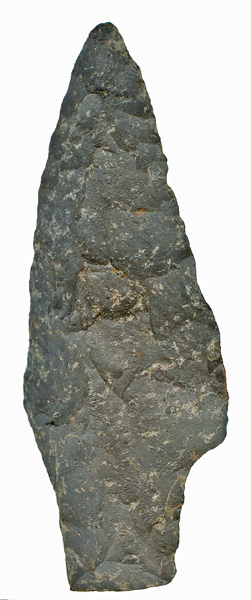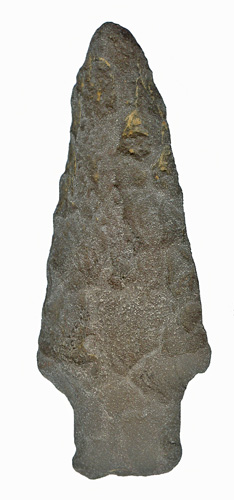



Point Type: BARE
ISLAND
Also See: Duncan's Island, Genesee, Lakawaxen, Lamoka , Neville,
Newmanstown, Piedmont, Piney Island, Poplar
Island
Location: Northeastern United States
Associated Dates:
4500 - 1500 B.P. - Late Archaic
Morphology: Stemmed
General Description: The Bare Island
point is a stemmed, medium to large sized, finely flaked, point
having a slender isosceles triangular shaped blade. The stem is straight with generally parallel sides and
the basal edge
is also straight.
The blade is usually slender in
shape although extreme narrow-bladed examples are in the minority. The
blade can exhibit considerable symmetry and some blades show asymmetry with
one blade edge being straight and the other being
excurvate. The blade edges are generally straight to convex with the edges of larger specimens
tending to be straighter. Greatest convexity usually occurs at the middle
of the blade. Tips are sharply pointed and are always on center with
the stem although there is no distinct medial ridge. Points made of quartz are
thicker that those manufactured from other lithic materials. Probably this
is a function of the way quartz flakes, rather than a trait of the cultural
significance.
Shoulders are slightly rounded and tapered but
not conspicuously so. On a few specimens the shoulders are quite sharply
angled and well defined but may have asymmetrical shoulders and some specimens
have a shoulder totally missing. An obtuse
angle is formed between the
blade and the stem, but in some instances a right angle is present. There
are intergrades between the Bare Island point type and the Poplar Island
point, but the rounded shoulder is conspicuous on the latter type. This
is a distinguishing characteristic. The shoulder on the Bare Island
point type is generally more crisp if present.
The stem is always narrower than the blade. The long
sides of the stem are parallel or nearly so and form a nearly perfect square or
rectangle. The base of the stem is usually quite straight, but it is
sometimes slightly convex. A few examples intergrade with a large
corner-notched point form that has an expanded stem. There are often
traces of grinding along the stem edges and at the
base. Corners of the stem approach right angles and on some specimens they
are quite sharp.
The type is found in the lower Susquehanna Valley,
particularly the river islands in the valley. The range extends southward
along the Elk River in Maryland, the Chesapeake and the lower Potomac.
East of the Susquehanna, it is found along the headwater of the White Clay Creek
and the Brandywine in Chester County. West of the Susquehanna the type is not
common in the Adams and Franklin County sections of the Cumberland Valley.
The distribution of these points extends across New Jersey and into southern and
eastern New York and southeastern Connecticut along Long Island sound. The
point occurs in some abundance on Staten Island and Long Island and with
diminishing frequency northward and up into the Hudson Valley at least to
Saratoga County.
Justice indicates that the Bare Island type is a part
of the Lamoka Cluster
of points. Fogelman suggests the
Bare Island is a resharpened Duncan's Island point.
The size of the Bare
Island ranges from 30 mm to 98 mm in length with the average being about 51
mm. In cross section the point is oval and relatively thick.
The
Bare Island was made from quartz, quartzite and rhyolite, siltstone, argillite
with very few made from flint, gneiss and schist.
The Bare Island point
type was named by W. Fred Kinsey III in 1959 for the Bare Island site in
Pennsylvania.
About the Point Above (Left): The point pictured at the top left hand side of this page, is from Staten Island, New York and was found along the banks of the Hudson river. One side of the blade has a strong shoulder while the other shoulder is quite weak and a strong bevel indicates that the left side of the blade and shoulder was reworked. This is a very thick speciment made from a dark black siltstone. The point measures 89 mm in length, 34 mm wide and 13.6 mm at its thickest point. The stem is 18.5 mm wide and is 20 mm long. The stem sides are ground smooth and the stem is much thinner than the blade (8.7 mm thick at mid stem). The basal edge of the stem is ground. This blade is very interesting. One face is very highly weathered and eroded and the face shown in the photo above still shows knapping scars. The blade edges reveal some fine retouch and microscopic examination shows use wear on both blade edges although erosion may have caused some of this wear as well. Catalog Number 161-65-V
About the Point Above (Right): The point pictured at the top right hand side of this page, was found in New London, Connecticut along the shoreline of Long Island Sound and is from the former George Zalesky collection. This blade exhibits two strong shoulders and is quite symmetrical. This is a somewhat thick specimen made from a dark black weathered siltstone. The point measures 71 mm in length, 29 mm wide and 9.6 mm at its thickest point. The stem is 18 mm wide and is 16 mm long. The stem sides are ground smooth and the stem is thinner than the blade (7.3 mm thick at mid stem). The basal edge of the stem is ground. This specimen very highly weathered and eroded but still shows knapping scars. Catalog Number 269-87-DD
References: Fogleman, Hranicky (1), Justice (1), Overstreet
© Copyright 1997 - 2009 LITHICS-Net WWW.LITHICSNET.COM
Use Your Browser's BACK Button to Return to the LITHICS-Net Index.